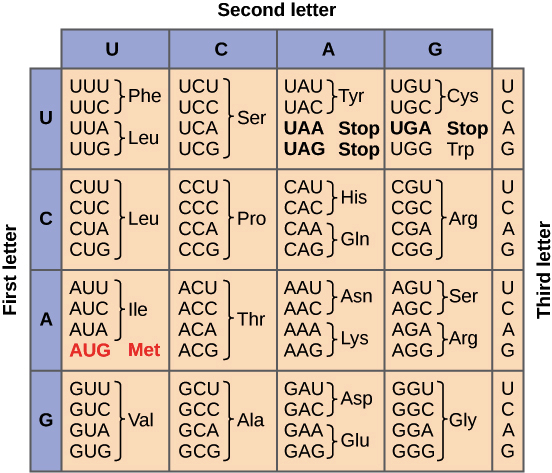What is the Central Dogma of biology?
DNA --> (transcription) --> RNA --> (translation) --> Protein
Please list the three overall steps of translation.
Initiation
Elongation
Termination
Give an example of an "on" operon and an "off" operon
"on" = trp - initially on but turned off by high levels of trp
"off" = lac - initially off but turned on by high levels of lactose and low levels of glucose
Despite having the same genome, what allows for numerous different cell types?
differential gene expression
Which type of mutation is passed on to offspring?
Germline mutation
What are the three stop codons?
UAG, UAA, UGA
What are the subunits of a prokaryotic ribosome? (please provide the svedberg units as well)
prokaryotes: large (50s) + small (30s) = ribosome (70s)
eukaryotes: large (60s) + small (40s) = ribosome (80s)
List the basic elements of an operon.
List the two modifications to histones that can change accessibility to DNA.
histone acetylation - opens up chromatin structure promoting transcription
histone methylation - closes off chromatin structure preventing transcription
List two causative agents of mutagenesis.
UV rays, radioactivity, carcinogens
 What will the anticodon of a tRNA carrying threonine be?
What will the anticodon of a tRNA carrying threonine be?
UG_ - (A,G,U,C)
What are the three subunits in a ribosome and what are their functions
P - peptidyl - holds tRNA with growing peptide chain
A - aminoacyl - site for tRNA with next amino acid in sequence to enter ribosome
E - exit - not actually occupied by tRNA; exit site for exhausted tRNA's
What happens to the trp operon at high levels of tryptophan.
When tryptophan is high, it binds to the repressor. The repressor undergoes a conformational change which allows it to bind to the operator. When the repressor is bound to the operator, RNA pol cannot cross the operator to the coding regions so no transcription will occur. This means tryptophan expression (production) will cease until tryptophan levels drop again.
How do transcription factors affect differential gene expression?
All cells require general transcription factors.
Different cells have different specific transcription factors and different combinations of these factors allow for differential gene expression.
Why are insertion/deletion mutations especially harmul?

Consider the following gene sequence: AUGACACUAGAG
How is the protein product affected if the underlined C was deleted from the gene sequence?
Initial protein product: met-thr-leu-glu
New gene sequence: AUG AAC UAG AG
frameshift + nonsense mutation
New mutant protein product: met-asn
Account for the energy used in the three steps and explain why energy is being used.
Initiation: 1 GTP - recruitment of large subunit to small subunit with bound mRNA
Elongation: 1 GTP - recruit charged tRNA to ribosome; 1 GTP - translocation of ribosome to next codon
Termination: 2 GTP - dissociation of ribosomal subunits
What occurs at high levels of glucose AND lactose?
At high levels of glucose, cAMP levels are low which means CRP levels are low. This means transcription of lactose is not promoted. High levels of lactose means that lactose can bind to the repressor and remove it from the operator so transcription of lactase genes is possible. There will be low expression of lactase.
A scientist is observing a mutant cell line. They notice that despite having sufficient general and specific transcription factors, a particular gene is not being expressed. All of the translation machinery is normal in the cell. Where could the mutation(s) lie?
Missing distal control elements - no place for activators to bind to
Missing mediator proteins - cannot mediate control by enhancers to promoter
A scientist is observing a mutant cell line. They notice that the cell contains many mismatched pairs in the DNA. Where does the mutation lie?
Cell is unable to conduct mismatch repair.
A scientist is observing a mutant cell line. She observes that initially translation proceeds normally but soon translation rates decline and quickly stops. She also observes that when she exogenously provides charged tRNA's translation resumes and then stops again. Where does the mutation lie?
mutant Aminoacyl-tRNA synthetase - unable to charge tRNA's
When the cell is young it inherits some charged tRNA's from parent cell which allow for initial translation. When these tRNA's are depleted translation stops. Exogenous insertion of tRNA's allows for resumption of translation but stops again when these are exhausted as well.
A scientist is observing a mutant cell line. They observe that this cell is unable to produce protein. They notice that the cell is undergoing transcription, contains charged tRNAs and has an abundance of GTP. They also find that some of the mRNA is bound to a ribonucleoprotein. Where does the mutation lie?
mutant large subunit
Cell has all the materials it needs to conduct translation: mRNA, charged tRNAs and energy. The mRNA bound to ribonucleoprotein is the mRNA bound the small ribosomal subunit. Therefore the only piece missing is the large subunit.
A scientist is observing a mutant cell line. They observe that regardless of glucose and lactose levels in the cell, lactose is never digested. They notice that RNA pol can successfully bind to the promoter but no functional lactase is produced. Where do the mutation(s) in the operon lie?
mutant repressor - unable to bind lactose so it never leaves the operator
mutant lactase gene - the operon works just fine but the protein product is dysfunctional so no lactose is digested.
How do transcription factors and chromatin regulation affect differential gene expression?
All cells require general transcription factors.
Different cells can have different specific transcription factors and access to different parts of the genome. Combination of specific transcription factors in different parts of the genome results in differential gene expression and ensures that unneeded genes will not be expressed.
Explain the cause of sickle cell anemia.
Glutamine residue is substituted by a valine residue. Valine tends to form fibers in low O2 conditions. This causes the cell to condense and crystallize resulting in the sickle shape.